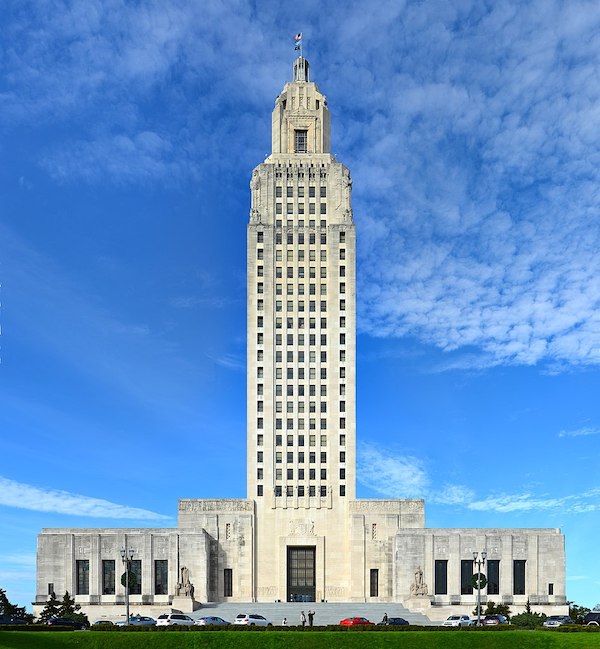
Lafourche man loved being outdoors, helping others
June 21, 2016
Houma native raising money for overseas trip
June 21, 2016A war of words arising due to existing tensions between two local Native American tribes has resulted in the cancellation of an event scheduled by New Orleans artists to draw attention to Louisiana’s diminishing coast.
But organizers say the aborted “End of the Road” event, which was to have been held Saturday on Island Road, between the Pointe-aux-Chenes mainland and a vulnerable, climate-doomed Isle de Jean Charles, will be scheduled for another time. The artist who conceptualized the idea of 500 people standing on the spit of highway between the mainland and the island spelling out the word “HOME,” to be photographed by a drone, said she will still appear on the highway as scheduled, bearing a sign.
“The official reason for the cancellation is public safety,” said the artist, Dawn DeDeaux. “But folks are welcome to come to the road where I will be holding my little sign, which says HOME Saturday, June 25, from 1 p.m. In the week of post-Orlando we cannot risk public safety.”
Plans were well in the works for as many as 500 tourists and art devotees, from the New Orleans area as well as communities in and around Terrebonne Parish, to travel by private auto and also in donated busses to Pointe-aux-Chenes, trekking to the spot where the human signage would be formed. After the event, they were to go onto the island and lunch at the Isle de Jean Charles Marina, owned by Theo Chaisson of the United Houma Nation.
Biloxi-Chitimacha-Choctaw Traditional Chief Albert Naquin, whose tribal members make up the majority of the island’s residents, objected to the event.
“I would like them to stay home,” said Chief Naquin in an interview. “First off, there is no benefit for the island people, all of it is for the artists. I do not think having a party on the Island Road is going to heal the cancer of land loss.”
Naquin saw the photo event as an exploitation of the island peoples’ plight.
A permit for the event was issued by the Terrebonne Parish Consolidated Government. It was applied for by a sponsor of the event, Prospect New Orleans, a non-profit that showcases artistry in “both historic and culturally exceptional” settings. In particular, such projects are intended to “contribute to the cultural economy of New Orleans and the Louisiana gulf region,” according to the organization’s website. Members of the tribe and their supporters had planned to address the Terrebonne Parish Council this week, seeking, they said, to have the permit pulled.
Not all members of Chief Naquin’s tribe were in favor of rolling up the welcome mat, however.
Levis Dardar, a long-time island resident, says if strangers come from many places to take part in Saturday’s event, it could be good for the island.
“Let the people come,” he said. “They will spend money, maybe they’ll come back.”
The concerns over public safety arose from written communications between Chief Naquin and DeDeaux, which included an e-mail from the chief expressing his objections.
“I have not been contacted about this event and I don’t approve of it and neither does the tribal council,” Naquin’s e-mail states. “Unless you want all hell to break loose, you need to cancel this event. I am the traditional chief of Isle de Jean Charles and I am not in favor of outsiders to make plans about my community without me being contacted first. I don’t know who’s (sic) idea this was, but we the people of Isle de Jean Charles are fed up with this kind of exploitation. Call it off or it will get ugly.”
A supporter of the tribe, Mark Fortson, whose wife is a member, had also expressed his displeasure, and solidarity with the chief, in an e-mail to organizers.
“At the island road, you may find a substantial number of tribal members insisting that you stay off. Take your publicity elsewhere,” Fortner’s email states. “The inhabitants have become tiresome of the exploitation. Where do you think the hundreds of families that have been forced from the Island over the last several decades and numerous storms have gone? They live nearby, mostly in Pointe-aux-Chenes, Chauvin, Houma and Montegut. You’ll pass their houses on the way to the Island Road. They are the dislocated. They are also those tired of empty and hollow causes on their behalf, and they may easily find themselves blocking your event.”
Multiple interviews give strong indications that no individual or company will financially benefit from the images that will result from the staged event. Prospect New Orleans had a lot of support from backers that include the Lambent Foundation Fund of Tides Foundation, Whitney Bank, Ralph and Susan Brennan, the Joan Mitchell Foundation, the RosaMary Foundation, the Keller Family Foundation, the Arts Council of New Orleans, Regions Bank and the Jewish Endowment Foundation of Louisiana.
Fortson criticized in particular involvement of the United Houma Nation. The UHN’s past involvement with events or undertakings for donations, Fortson alleges, have done little good for the island’s residents. The UHN’s involvement is limited at this point to being part of the group of people donating use of vans for transport of participants, and perhaps food.
DeDeaux said she tried to contact Chief Naquin but that he did not return her calls; she then made contact with Theo Chaisson at his marina, and he as well as other members of the UHN, both on and off the island, appeared warm to the event.
Chief Naquin maintains that if outsiders want to exploit the island’s plight they do so in ways that can result in direct financial aid to its residents. He cites a woman on the island whose roof was damaged by heavy rains and cannot afford to repair it.
DeDeaux and Chief Naquin met for several hours last Monday in Montegut to discuss her plans and his concerns. The discussion did not go well, however. The United Houma Nation’s involvement, however minimal, rankled some Biloxi-Chitimacha-Choctaw people, who are still stinging from a shift in Louisiana’s plan to finance a move off the island with a $48 million award. The UHN raised objections to that and sought to be included in the decision making process, under a claim that restricting the funding to Chief Naquin’s band of island natives would have cut out members of their group from participating.
A shift in Louisiana’s initial plans to limit the move to Naquin’s people is, in Fortson’s opinion, what anyone wishing to aid them should focus on.
“I think instead of parading up and down the island road illustrating the scale of the loss of land, you might rather try to assist them in their present cause, convincing the State to proceed with honoring their commitment to the island tribe,” Fortson wrote. “The island is lost. It’s been losing for decades. Your project is a day late and a dollar short.”
DeDeaux said the UHN’s name – with its permission – was placed on initial publicity fliers “because we were happy to have participation from the local area and added their logo immediately, as we thought this would encourage more locals to join us.”
“I confess that I had no idea how bad the relationships were among the varied tribes. In no way was this a schemed partnership with the UHN,” DeDeaux said. “It’s terrible that all this hard work and resources have been wasted. It is such an important cause.”
Media fatigue on the part of some island residents and former residents is at times palpable.
Spotlights drawn by Hurricane Gustav and other weather and other events, the perennial discovery and re-discovery of the island and its plight with each new generation of national environmental reporters, the 2010 BP oil spill and other events that make the island people interesting subjects for student film documentaries and other projects make the people no better off than they were before, some residents have complained.
The federal government, the state and local entities have made clear that Isle de Jean Charles is not in their opinions worth saving, even as efforts to protect the rest of the coast continue. It has deliberately been excluded from any plans for interlocking levees and floodgates that will protect the rest of Terrebonne Parish, and so many of its residents are publicity-weary.
The island’s residents have most recently been depicted in international media as “climate refugees,” the first indigenous people to be moved through means of a government program because of climate change. The move is by no means finalized, however, and many island residents say they want to stay put, though they realize that may not be possible.
The delicate nature of relations between Native American tribes in the Bayou Region has posed many challenges for reporters and government officials – often well-meaning – who inadvertently slight one group in favor of another. Members of Gov. John Bel Edwards’ administration learned that when his term was spanking new, after they were accused of not having talks on the matter of relocation money with the United Houma Nation, initially.
Neither the UHN nor the Biloxi-Chitimacha-Choctaw Isle de Jean Charles Band are recognized by the U.S. Bureau of Indian Affairs. Both are recognized by the State of Louisiana, however.
In many cases, people claiming UHN membership are also members of tribes like Chief Naquin’s, and further confusing matters are the layers of familial relationships spanning particular tribe or organizational ties.
Ironically, Chief Naquin told The Times late Friday that his group planned to drop its opposition to the event.
High-ranking officials at the Terrebonne Parish Sheriff’s Office, who had several meetings regarding security for the now-canceled event, said they are in receipt of the e-mails perceived as threatening. They also expressed confidence that they could manage any issues that came up regarding conflicting groups.
DeDeaux said the concept of the human chain spelling out HOME came to her after seeing aerial photos of Louisiana’s shrinking lands, often used by advocacy groups to raise awareness regarding coastal erosion. The photos are sterile, however, and do not communicate the concept that humans live on many of the places where only thin strips of land exist. The purpose of the photos, she said, was to drive that point home.
After a story appeared on houmatimes.com about the event cancelation, DeDeaux released a formal statement on the matter.
“The arts community together with our partnering organizations have succeeded in making a work of conceptual art,” she said. “We have succeeded in amassing the commitment of hundreds of people from south Louisiana to stand in unity on what will remain for now an imaginary road. For reasons unrelated to our mission to highlight coastal erosion, threats of violence aimed at one of our tribal nation participants have been taken seriously enough to prompt a postponement of the June 25th event. This specific gathering was only one extension of a project that will continue; and it just may become a catalyst for a degree of reconciliation among area tribes – each under immense pressure to navigate the harsh challenges of life at the frontline of coastal erosion, a place where the ways of life are threatened. This was an opportunity for all of us to put down our differences for just 30 minutes and focus on what we share in common – our deep love for this sacred Louisiana land slipping into the sea. The tragedy calls out for our immediate, collective stewardship – and forgiveness. Ironically, a project titled END OF THE ROAD finds itself at the beginning of a new road, one that we hope you will continue to follow.” •
Senior Staff Writer











